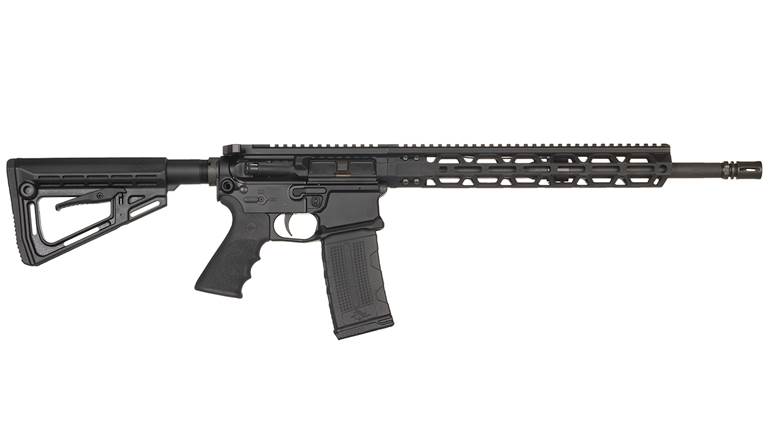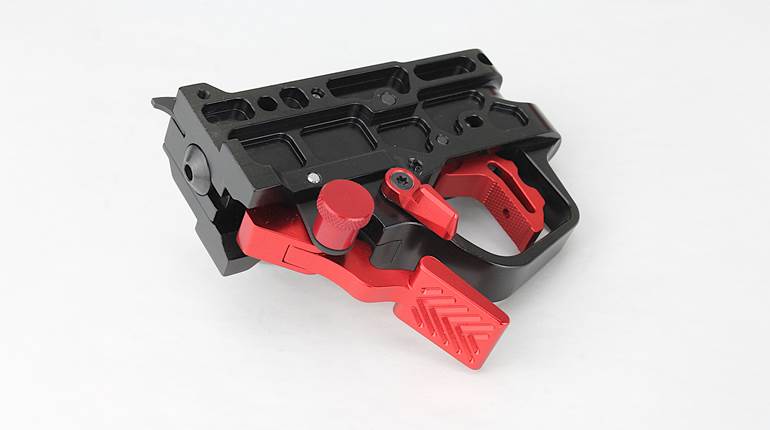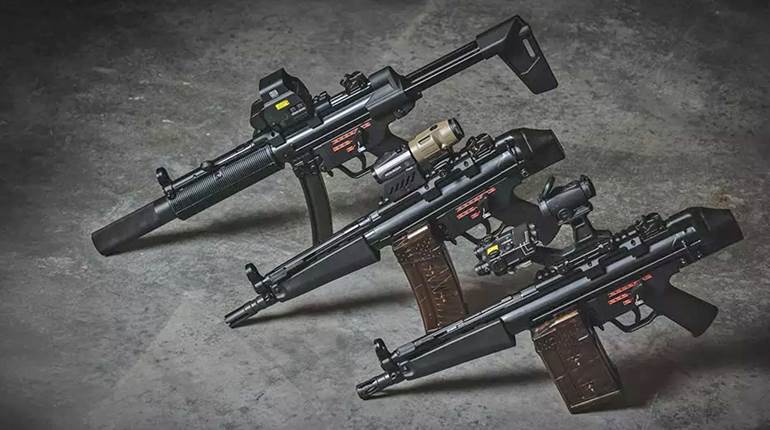
This article, "The Pedersen Device: Never In Anger," appeared originally in the June 2003 issue of American Rifleman. To subscribe to the magazine, visit the NRA membership page here and select American Rifleman as your member magazine.
At the time of the United States’ active involvement in World War I, the M1903 rifle was the nation’s standard military service rifle. The U.S. M1917 Enfield rifle was soon adopted to supplement the supply of M1903s, and both were issued to and used by our “Doughboys” in large numbers during the war.
While the M1903 and M1917 were reliable, accurate, and powerful, they shared two drawbacks in common with all bolt-action military service rifles; the mechanism was slow to operate and the standard cartridge was overly powerful for some combat applications. These issues were discussed in an issue of Army Ordnance magazine:
“It may seem at first glance that the military rifle cartridge is unduly powerful but it must be remembered that this cartridge is intended to be used against various targets such as airplanes, armored cars, tanks, etc. … These same bullets are used by machine guns for laying out barrages at long distances or for shooting at high flying aircraft.

“Thus a soldier in firing his army rifle is frequently in a situation where he has more power in his bullets than he needs for a particular job in hand; moreover for each shot he must open the bolt of his gun and throw out the empty cartridge and then close the bolt and lock it before he can shoot another shot."
In other words, it was not always necessary that a soldier have a full-power cartridge, but there were times when such cartridges were indispensable. Also, a self-loading or semi-automatic rifle would have been quite desirable, but no satisfactory arms of this type capable of handling full-power military cartridges were available.
A reasonable solution to these seemingly contradictory problems seemed quite unlikely. However, an innovative and technologically imaginative mechanism was developed to address the situation. The resulting mechanism is termed the “Pedersen Device.”

This device was conceived in the fertile mind of John D. Pedersen who was a talented and well-known arms designer during that period. Pedersen had previously designed several commercially successfully arms including the Remington Model 10 slide-action shotgun and the Model 51 autoloading pistol.
Pedersen did most of his experimental and developmental work while affiliated with the Remington Arms Co. In the late 1920s and early 1930s Pedersen developed a semi-automatic service rifle that was a serious competitor to the rifle designed by John Garand that was subsequently adopted as the M1.

Pedersen labored at his new invention until the summer of 1917 when he contacted the U.S. Army Ordnance Department to request a secret demonstration of the fruits of his labor. Although the Ordnance people had no idea as to the nature of his invention, Pedersen’s reputation and standing in the ordnance community was such that his request was soon granted.
On October 8, 1917, Chief of Ordnance General William Crozier, along with a specially selected group of army officers and congressmen all sworn to secrecy, assembled at the Congress Heights rifle range in Washington, D.C. The following details of the demonstration were related a number of years later in an issue of Army Ordnance magazine:

“Mr. Pedersen started his demonstration by firing the Springfield rifle which he brought with him. After firing a few shots in the ordinary way he suddenly jerked the bolt out of the rifle and dropped it into a pouch which he had with him, and from a long scabbard which was on his belt he produced a mysterious looking piece of mechanism which he quickly slid into the rifle in place of the bolt, locking the device to the rifle by turning a catch provided for the purpose. Then he snapped into place a long black magazine containing forty small pistol size cartridges whose bullets were, however, of the right diameter to fit the barrel of the rifle. All this was done in an instant and in another instant Mr. Pedersen was pulling the trigger of the rifle time after time as fast as he could work his finger and each time he pulled the trigger the rifle fired a shot, threw out the empty cartridge and reloaded itself.”
The assembled onlookers were amazed by Pedersen’s demonstration, and the device was eagerly examined at length. The mechanism was termed by Pedersen as an “automatic bolt” that allowed the Springfield rifle to be fired semi-automatically. It eventually became known as the “Pedersen Device.” The device operated in much the same manner as a blowback-operated pistol. The “barrel” of the device was the same configuration as a .30-’06 Sprg. cartridge and was rifled (with shallow lands and grooves).

The device locked into the rifle by means of the magazine cut-off that was slightly modified. A small projection on the rifle’s trigger moved forward each time the trigger was pulled, which tripped the device’s sear. Therefore, each time the rifle’s trigger was pulled, the device fired. None of the minor modifications to the rifle prevented it from firing .30-’06 cartridges with the standard bolt inserted.
A 40-round-capacity box magazine was attached to the right side of the device and held in place by two spring-loaded “fingers.”

The magazine was inserted at about a 45 degree angle, which allowed the standard rifle sights to be used. Fired cartridge cases were ejected through an oval opening milled into the left side of the rifle’s receiver. The cartridge resembled a rimless, extra-long .32 ACP pistol round but differed a bit in size and ballistic performance.
The round was .30 caliber so as to be compatible with the ’03’s bore and was loaded with approximately 3.5 grs. of smokeless powder. When fired through an ’03, the muzzle velocity of the 80-gr. FMJ bullet was about 1300 f.p.s. with a muzzle energy of approximately 300 ft.-lbs.—nearly 50 percent greater than comparable rounds fired from a handgun.
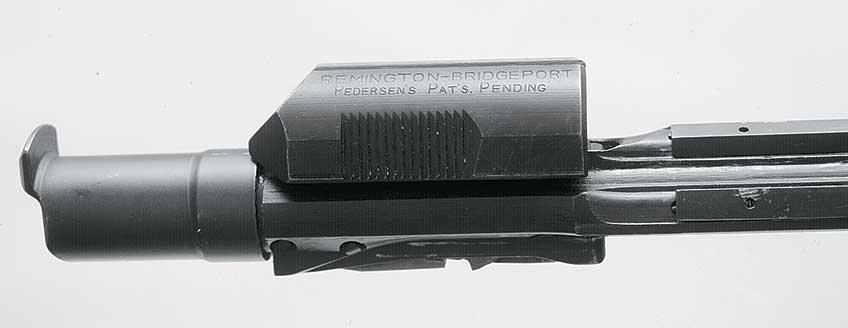
The device was to be carried in a stamped, sheet metal scabbard, and the standard ’03 bolt was to be contained in a canvas pouch when it was removed from the rifle. Five Pedersen Device magazines were carried in a five-cell canvas pouch. The metal scabbard and both types of canvas pouches were designed to be attached to the standard infantry cartridge belt. The device, complete with its metal carrying scabbard, weighed about 2 lbs., 2 ozs., and one fully loaded magazine weighed about 1 lb.
Those who witnessed Pedersen’s demonstration, especially the military observers, quickly grasped the potential significance of the device. There was a great deal of concern in the United States at the time regarding new and innovative arms that might help save American lives in the trench warfare environment being encountered by our troops in France. It was believed that the Pedersen Device could be an enormous asset for both offensive and defensive purposes. An ordnance officer made the following observations regarding the Pedersen Device’s defensive role:
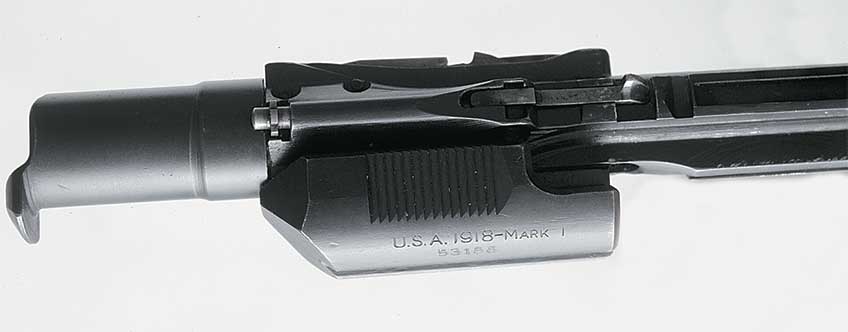
“As the enemy came charging across No Man’s Land each of our soldiers would start firing with this miniature machine gun and the entire zone in front of the trenches would be covered with such a whirlwind of fire that no attack could survive ... .” The same officer had equally high expectations of the Pedersen device’s performance as an offensive arm:
“[A] line of soldiers advancing across No Man’s Land firing this device at the enemy trenches as they ran would make it extremely difficult for anyone in the trenches to show his head or any part of his body. Of course, fire while running or walking would not be so accurate, but the tremendous number of shots would more than make up for any inaccuracies and the whole enemy trench system would presumably be smothered with a storm of bullets.”
The War Department was sufficiently impressed with the preliminary demonstration of the device to order an ordnance officer, Captain J.C. Beatty, to France in November 1917 to deliver an example of the Pedersen Device to General Pershing. Captain Beatty was sworn to secrecy and the entire project was cloaked with a “Top Secret” status.
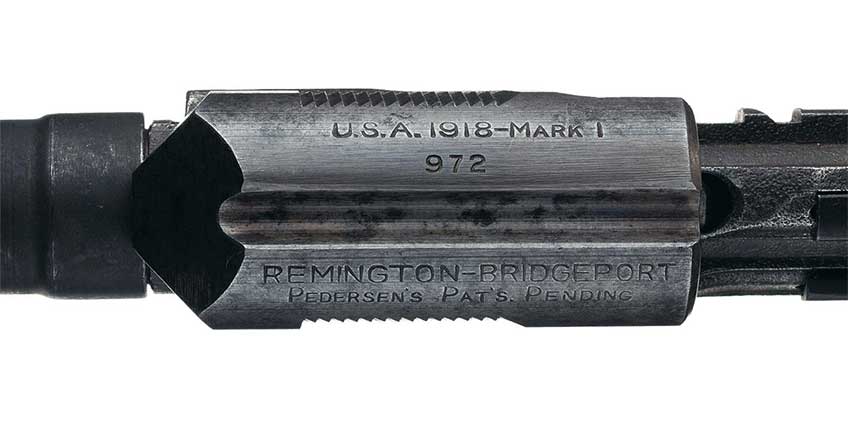
A board was convened by General Pershing on December 9, 1917, at Langres, France, to evaluate the “secret weapon.” The board consisted of four high-ranking U.S. Army officers accompanied by Captain Beatty. The board supervised testing of the device for accuracy, penetration, rapidity of fire and endurance. After the initial testing, the board agreed that the device could be of great value for both offensive and defensive use. General Pershing was favorably impressed with the Pedersen Device and dictated the following confidential memorandum dated December 11, 1917:
For the Chief of Staff and Chief of Ordnance. Board recommends adoption of Pedersen attachment for rifle and the initial purchase of 100,000 of same. Great secrecy urged in connection with this device. Initial supply of ammunition 5,000 rounds per gun with daily supply of 100 rounds per gun. Strongly approve of device and believe it will materially increase efficiency of our infantry. Pershing”
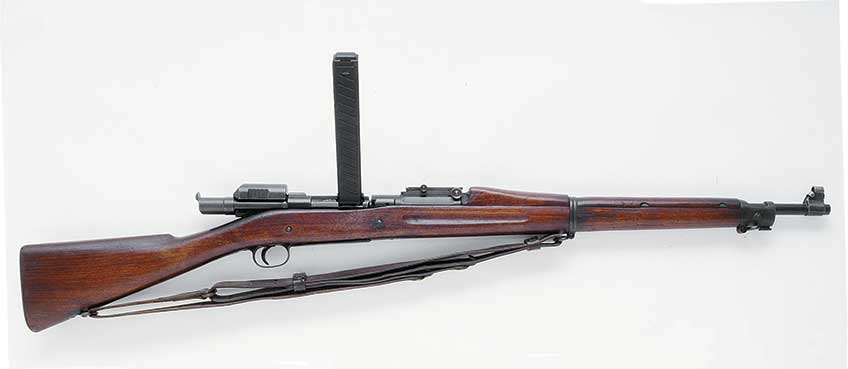
The initial order for 100,000 Pedersen Devices was placed with Remington Arms Co. on March 26, 1918. The company was to receive a net profit of $2.00 per device and 3 cents per magazine. John Pedersen was paid $50,000 for the rights to his device, along with a royalty of 50 cents for each one manufactured. The government paid for all necessary machinery and equipment required by Remington to produce the Pedersen Device. The initial order for 100,000 was soon increased to 133,450.
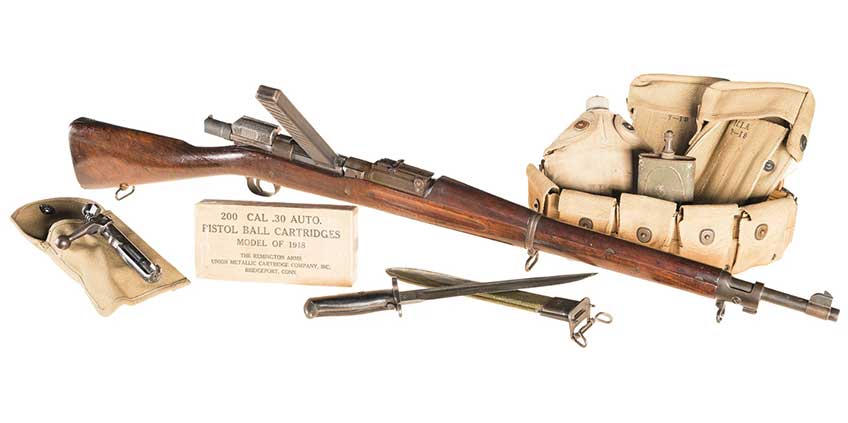
On May 24, 1918, Remington was granted a contract to produced 800 million Pedersen Device cartridges. The cartridges were head-stamped “RA” or “RAH” and dated with the last two digits of the year of production (“18”, “19” and “20” have been observed). The “RAH” head-stamped cartridges are believed to have been produced at the Remington plant in Hoboken, N.J. The cartridges were packed in 40-round boxes, thus each box would fill one magazine. Five boxes were packed in a 200-round carton and three cartons (600 rounds) were carried in a light canvas bandolier. Five bandoliers were packed in a wooden crate.
Production of the Pedersen Device magazines was reportedly subcontracted to the firm of Mt. Vernon Silversmiths with some components further subcontracted to the Gorham Company. The magazines were constructed with viewing slots (facing the firer) so that the number of rounds remaining could be easily determined. Five magazines were carried in a web pouch and two or three pouches could be carried on the standard infantry cartridge belt.

The pouches were fabricated by Rock Island Arsenal and stamped with the date of production. A canvas pouch designed to hang vertically from the belt was also produced to carry the rifle’s bolt when removed from the rifle. Two stamped sheet metal wrenches were to be issued with each device for adjustment and disassembly purposes. The stamped metal scabbards were reportedly manufactured by the Gorham Company. The unmarked scabbards were fitted with cartridge belt hooks and had a hinged top with a wire closing latch.
As Remington began to tool up for manufacture of the Pedersen Devices, Springfield Armory was directed to begin production of a modified M1903 rifle to be designated as the “U.S. Rifle, Caliber .30, Model of 1903, Mark I.” The Mark I rifle differed from standard M1903 rifle of the period in several respects.
These included the ejection port milled into the left side of the receiver, a slightly cut-away section in the stock under the port to provide clearance and a modified sear, trigger and magazine cut-off. The “Mark I” marking was added to the receiver ring. None of the modifications of the Mark I rifle affected firing in the normal manner with the service cartridge (.30-’06) when the standard bolt was inserted.

As Remington and Springfield labored on getting the Pedersen Devices and M1903 Mark I rifles into production, the War Department was busily formulating plans on how to best utilize the new “secret weapon” in combat overseas. It was envisioned that the Pedersen Device would play a large role in the massive “Grand Offensive” planned for the Spring of 1919 where it could conceivably be of great value.
However, it soon became apparent that production of the M1903 Mark I rifles would not be sufficient to meet this time frame. To this end, John Pedersen was requested to develop a version of his device for use with the M1917 rifle since it was being produced in much larger numbers than the M1903. The variant made for the M1917 rifle was designated as the “Automatic Pistol, Caliber .30, Mark II.” After preliminary testing, Remington was given a contract for the production of 500,000 Mark II Pedersen Devices to take effect when the original Mark I Pedersen Device contract was completed.
It is interesting to note that Remington also fabricated at least one prototype Pedersen Device for the Russian Mosin-Nagant rifle, which was based on the same design premise as the Mark I device but differed in some details. The fall of the Czarist government in Russia resulted in the cancellation of any potential Moisin-Nagant/Pedersen Device program. Reportedly, Remington also contemplated the production of a Pedersen Device for the French Berthier rifle, but it is not known if any were actually fabricated. Both the Mosin-Nagant and Berthier rifles were made during World War I under foreign contract by Remington.

The Mark I Pedersen Devices and M1903 Mark I Springfield rifle were beginning to come off the assembly lines when the Armistice was declared on November 11, 1918. The pending contract for Mark II Devices was soon cancelled with only a very few prototypes (likely less than a half dozen) being essentially hand-made by Remington. Production of the Mark I Pedersen Device continued until March 1, 1919 when that contract was also cancelled. By this time, some 65,000 Devices had been manufactured along with 1,600,000 magazines, 65,000,000 cartridges and the metal scabbards and canvas pouches.
The War Department had the Pedersen Devices but was not sure what to do with them since the war ended. Another ordnance board was convened to ascertain the Pedersen Device’s future role, if any, and to make appropriate recommendations. Tests were conducted in France soon after the conclusion of the war and subsequently in the United States at Fort Benning in 1919 and Fort Riley in 1920. In addition, some 4,000 M1903 Mark I rifles complete with Pedersen Devices were sent to Panama Canal Zone in 1920 for further field testing.
All of the various tests came to the same basic conclusion: that the Pedersen Device was unlikely to be of use in future wars. The low power of the cartridge, the added weight of the Device and related gear and the cumbersome changing back and forth between the rifle bolt and the device were all cited as deficiencies. The Pedersen Devices that were issued for testing were returned to Springfield Armory until their fate could be determined. Although the Pedersen Device’s “secret” status was maintained after the war, it eventually became apparent that the mechanism was never going to be utilized by the U.S. Army.

With no prospect for future use, it was decided in April 1931 to destroy all devices, magazines and ammunition in order to save the cost of continued storage. The devices and accessories were to be burned and disposed of as scrap metal at several selected ordnance facilities. It has been reported that some Pedersen Devices destroyed at the San Antonio Arsenal (Texas) were broken up and dumped for use as rebar into concrete sidewalks being poured at the time.
Beginning in 1937, the M1903 Mark I rifles were recalled to Springfield Armory for conversion to M1903 configuration by removing the special Mark I parts and replacing them with standard M1903 components. It is reported that many of the converted M1903 Mark I rifles were subsequently issued to National Guard units.
The “Mark I” designation on the receiver ring and the unusual ejection port milled into the receiver were likely a mystery to the soldiers who were issued the rifles since few had ever heard of a Pedersen Device due to its “secret” status. Virtually all of the M1903 Mark I rifles were eventually rebuilt by a number of ordnance facilities.

Except for a few given to museums and government reference collections, virtually all of the Pedersen Devices were destroyed except for a small number that were slipped into coat pockets, lunch boxes or otherwise surreptitiously removed from the destruction sites. Surviving examples of Pedersen Devices are rare and desirable collector items today. A number of specimens will show evidence of having been burned, which indicates they were likely retrieved from the edges of the destruction bonfires.
Some partially complete devices assembled from miscellaneous parts may also be encountered today. The metal carrying scabbards are even rarer than the Devices, and the magazines are quite uncommon as well. Some ammunition survived as the 40-round boxes are not extremely hard to find today, although the 200-round cartons and canvas bandoliers are rather rare.
The related web gear was apparently sold as surplus as the canvas bolt pouches are not too difficult to turn up today, and the five-cell magazine pouches are very common and inexpensive. The precise number of Pedersen Devices extant is not known and estimates range from a few dozen to perhaps 100, and condition ranges from pristine examples to burnt-out relics.

Even though it was never fired in anger and its tactical wisdom can be debated, the Pedersen Device is nevertheless a tribute to the genius of John Pedersen. It remains one of the most interesting and innovative items of military ordnance ever designed and put into production. It is too bad that the Pedersen Device never had the opportunity to demonstrate what it might have been able to accomplish on the battlefield. Today, it is a little-known but thoroughly fascinating footnote to United States ordnance history.
Excerpted in part from U.S. Infantry Weapons of the First World War by Bruce N. Canfield, Andrew Mowbray Publishers, Inc., 2000; www.manatarmsbookshelf.com.












